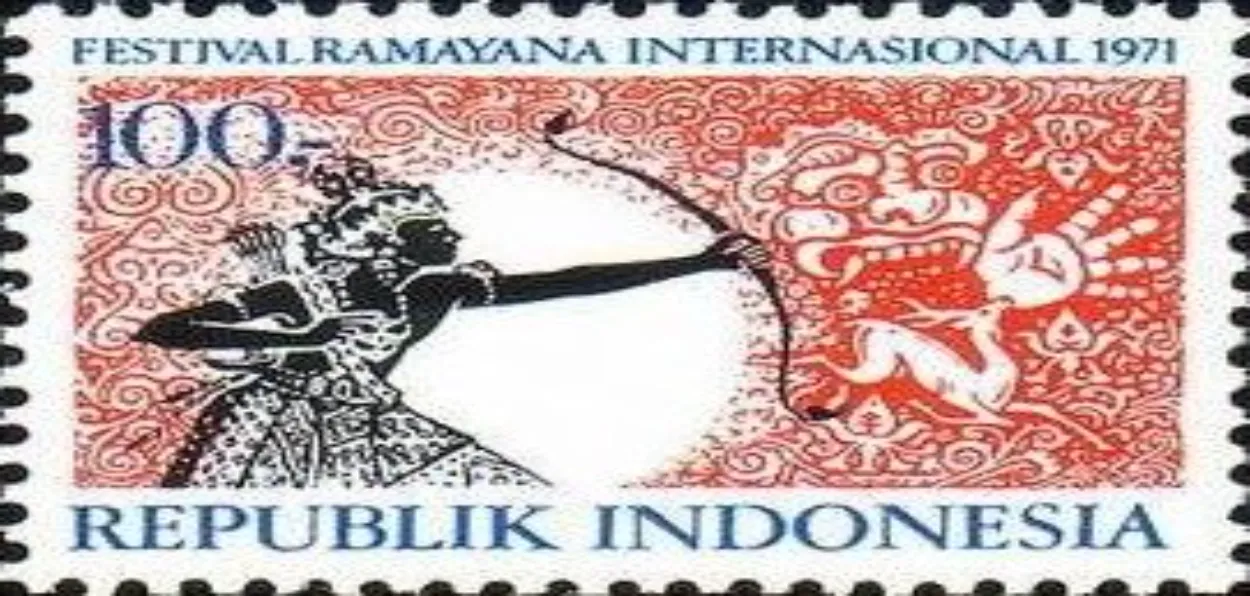
Dr. Ajit Vartak, Kalpana Vartak
The Indian Postal Department has issued stamps in different eras in honor of Ramayana. It depicts various scenes from Ramayana. Apart from this, saints and poets who wrote Ramayana in various languages have also been honoured. To celebrate the silver jubilee of ASEAN-India friendship, the tickets issued are also based on the Ramayana.
Valmiki Ramayana is the first classical epic in Sanskrit. There is no other book in the world that has had such a profound impact on the lives and thoughts of the people of many nations, including India.
In his Ramayana, Maharishi Valmiki has presented the ethics of how to lead an ideal life in the form of Rama. The message of Valmiki Ramayana is that human life is fleeting and one should live an ideal life like Rama by renouncing indulgences.
Adikavi Maharishi Valmiki was issued a twenty paisa postage stamp on 14th October 1970. This ticket depicts Maharishi Valmiki as well as important characters from Ramayana Rama, Sita, and Lakshmana. Maharishi Valmiki is believed to have been born on Ashwin Poornima.
 Stamps released by the Indian Postal department
Stamps released by the Indian Postal department
A set of eleven postage stamps on Ramayana was released on 22 September 2017. These tickets were unveiled by the Prime Minister at the Tulsi Manas temple built in honor of Saint Tulsidas in Varanasi. The first ten tickets are worth five rupees and the eleventh ticket is worth fifteen rupees.
The first ticket depicts Rama holding a Shiva bow and winning Sita-Swayamvara, with Sita standing next to her with a varmala in her hand.
The second ticket shows King Dasharatha in a very sad, troubled heart asking Rama to go into exile for 14 years.
Bharat has come to Chitrakoot on the third ticket. It is seen that Bharata is earnestly requesting Rama to return to Ayodhya and become the king of Ayodhya as it is right for Rama to rule Ayodhya.
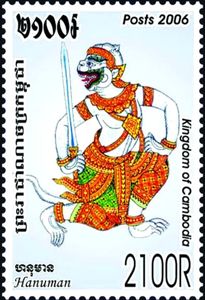 Stamp on Hanuman by
Stamp on Hanuman by
The fourth ticket shows Navadi Kevat taking Rama, Sita, and Lakshmana in his boat to cross the Ganges. On the fifth ticket, Ram is consoling, Jatayu, who is on his deathbed. Jatayu is depicted narrating to Rama the abduction of Sita by Ravana and his efforts to save her from him. On the sixth ticket, Sabari is seen offering (Bharvi) sweet sacks which she has tasted/picked up to Rama.
The seventh stamp depicts Hanuman in Ashoka Vatika showing Rama's ring to Sita, assuring them that they are his messengers.
On the eighth ticket, a bridge is being built across the ocean to reach Lanka and each brick/stone used to build the bridge has Rama's name written on it, making it light and floating on the water. Khar is seen in Rama's hand next door and he is patting her back. Legend has it that the three black stripes on Khari's back are caused by Rama moving his hand from her back.
On the ninth ticket, Hanuman, flying through the air, carries Mount Dronagiri to Lanka. Mount Dronagiri is depicted as the plant that revived Lakshmana, who had fallen unconscious during a battle with Ravana's army.
The tenth ticket shows Rama attacking Ravana's army with his monkey army. Having won the Lanka war on the eleventh ticket, safely freeing Sita, Rama returns to Ayodhya. In Ayodhya, Ram and Sita are seated on thrones and Hanuman and Rama's brothers Lakshmana and Bharata are depicted in the court.
On the first day cover of this time, the early poet Valmiki is shown writing the epic Ramayana in a grove on the left side. A miniature sheet and a souvenir sheet were also drawn along with these tickets.
Tickets on Ramayana’s Poets- Playwriter
In India, poems and dramas based on Ramayana were composed in different languages and at different times. Tickets were issued to some of its creators. India issued two postage stamps in honor of Kalidasa, the famous Sanskrit epic poet of the fifth century. Scenes from the plays 'Meghdoot' and 'Shakuntal' have been shown on it. Kalidasa's Ramayana epic Raghuvamsa is world-famous. 12th century Tamil poet Kamba composed the book "Kambaramayana". A ticket worth 15 paise was issued on 5th April 1966 on Kavi Kamb.
On April 26, 2017, a ticket worth five rupees was issued in honor of Atukuri Molla, a 15th-century poetess who wrote Ramayana in the Telugu language 'Molla Ramayanam'. The 16th-century Malayalam poet Thunchathu Ezhutchan wrote the Samhita of the Ramayana in the Malayalam language. The special cover on them was removed on November 11, 2011, by the Palakkad Department in Kerala.
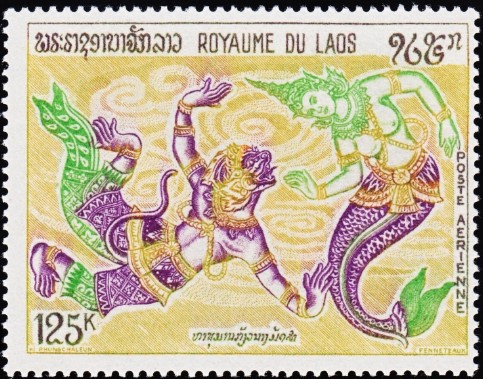 Stamp of Laos
Stamp of Laos
India issued a set of six postage stamps on saints and poets on 1 October 1952. One of the penny tickets is dedicated to Saint Tulsidas, the author of the Hindi epic 'Ram Charit Manas'. On the occasion of the 400th anniversary of this epic poem, as well as to spread the message of this great book all over the world, a ticket worth twenty-five paise was issued on 24th May 1975. The book Bhavartha Ramayana by the 16th-century Marathi saint-poet Eknath is famous. On 23rd March 2003, a postage stamp of Rs.5 was issued on Saint Eknath.
Twentieth-century Kannada poet K. V. Puttappa's poem 'Sri Ramayana Darshanam' is famous. On May 31, 2017, a ticket worth Rs. He received the Jnanpith Award in 1967 for his poem on Ramayana. He is the first Kannada poet to receive this award. A special cover was unveiled on 28 December 2017 to mark the 50th anniversary of the incident.
Twentieth-century Marathi poet known as modern-day Valmiki C. D. Madgulkar's epic 'Geetramayana' has a great place in the public mind. However, no stamp or special cover has been issued on them.
Ramleela featuring mask stamps
India issued a set of four stamps in 1974 on the theme 'Indian Masks'. One of the tickets shows the mask of Ravana used in the famous 'Ramleela' celebrated during Dussehra at Ramnagar near Banaras. These masks are made using paper pulp.
Paintings in the Mithila style
India issued a set of five stamps in 2000 on 'Madhubani/ Mithila Chitrashali'. One of the tickets has a picture of Vali and Sugriva drawn by Smt. Sanjula Devi. This style of painting is from the Mithila region of Bihar. It is believed that King Janaka of Mithila ordered the artists to decorate the city during the wedding ceremony of his daughter Sita and this style of painting originated from that. These pictures are painted with natural colors on the mud floor or wall of the house. Over time, in the twentieth century, it started to be drawn on paper, cloth, and canvas.
Stamps on Ramayana in ‘Greater India’ as well
Even in greater India, i.e. countries where Indian culture has been propagated and disseminated, many countries have depicted scenes and characters from the Ramayana on their postage stamps. The customs, beliefs, and influence of individuals in that country can be seen on those tickets.
Since ancient times, when there were no facilities, adventurous travelers, traders, and Indian people went out of India by land or sea. There they established their colonies and established their culture.
In Southeast Asian countries, the original story of the Ramayana and its characters remained the same; But the influence of local customs, beliefs, and individuals can be seen in the Ramayana of those countries. Many of our neighboring countries have featured Ramayana on their postage stamps.
Glorification of Sita in Nepal
ALSO READ:
Nepal is our neighbouring country. It has kept its independence intact till now. It is believed that Rama's wife (Janak Princess) Sita was born in Janakpur, Nepal. Two stamps were minted in 1962 and 2013 and a silver coin was minted in 2015 in honor of the nineteenth-century poet Bhanubhakta Acharya who wrote 'Bhanubhakta Ramayana' in Nepali language. Also, a ticket was issued in 1980 in honor of Siddhidas Maharaj who wrote 'Siddhi Ramayana' in Nepali language.
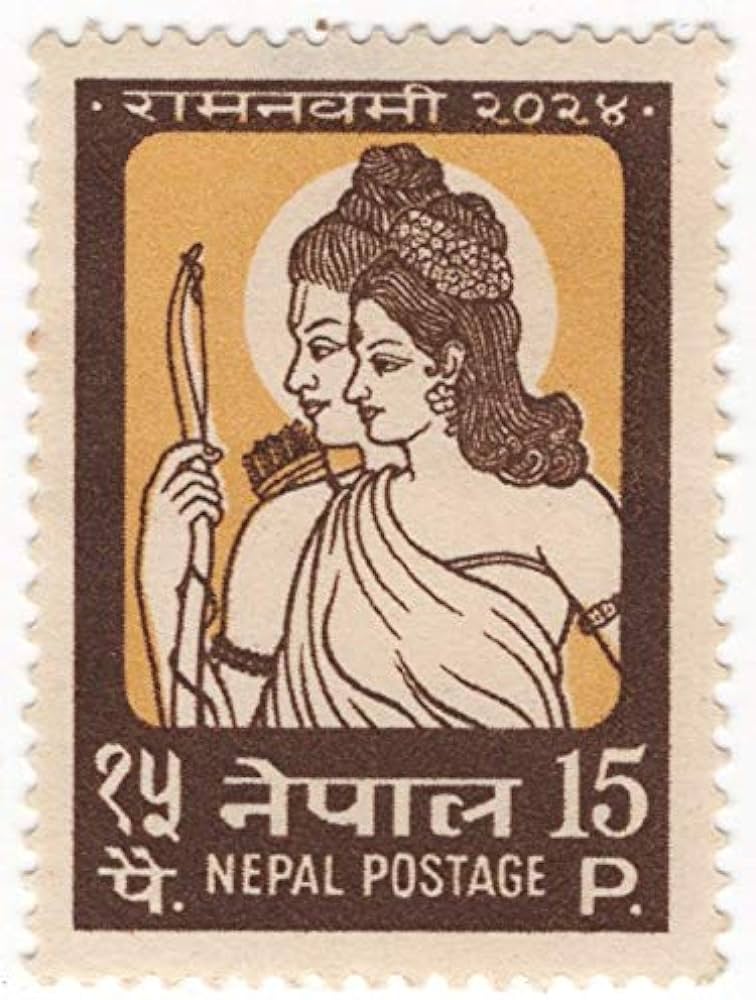 Stamp released by the Nepal government
Stamp released by the Nepal government
On the occasion of Ram Navami in 1967, a ticket with Kodandadhari Rama and Sita was issued. Tickets were issued on 7 May 1968 on the occasion of Sita Jayanti. This ticket shows Sita and the Sita temple at Janakpur. In 1974, the ticket was drawn on Janak Raja. In 1991, a ticket with a view of Ram-Sita Marriage Mandap, Janakpur was issued.
A set of stamps in Laos
Laos - Laos is the territory of the Lao people. The original name of Laos is 'Lavdesh'. This name comes from Rama's son 'Love'. A set of 6 stamps based on Ramayana was issued in 1955. Characters depicted in Phra Lak Phra Ram, the Lao text of the Ramayana, are on the ticket. The first ticket depicts Ram-Sita, and the second ticket depicts the characters of the Kalasutri puppet show based on the Ramayana. The third ticket has a picture of Rama. Ravana is shown on the fourth ticket and Hanuman on the fifth ticket. The sixth ticket depicts a monkey.
In 1969, a set of 8 stamps based on Ramayana was issued. One of these tickets depicts the Jatayu-Ravana battle. One depicts Sita undergoing an ordeal. A ticket was issued in 1970. It shows Angad taking Meghnad's head on a platter. A stamp issued in 1971 depicts the battle between Matsya and Hanuman. In 2004, the country released a set of 4 stamps based on the Ramayana. One ticket depicts the scene of Rama's slaying of Vali. Xieng Khouane Buddha Temple near Vientiane city has a stone sculpture of Hanuman and Matsya. A ticket featuring this stone sculpture was issued in 2006.
Cambodian stamps featuring Hanuman
An important country in Southeast Asia. This country got its name from the Indian king Kambu. The world's largest temple 'Ankorvat (of Vishnu)' is in this country and is depicted on the country's flag. A monkey attack on Ravana's brother Kumbhakarna on a sculpture in the Ankorvat temple complex is shown on the ticket. Reamker of this country is based on the epic Ramayana. Reemker means 'Glory of Rama'.
In 1964, Cambodia issued a set of five stamps on Hanuman. A ticket in 1967 shows actors performing a ballet in the role of Ram-Sita. A ticket was issued in 2001 depicting Mastyakanya and Hanuman. A set of five stamps was issued in 2006. On these tickets are Rama's sons Lav-Kush practicing archery respectively; Rama, Sita, Ravana, and Hanuman are depicted. Also, a miniature sheet is drawn on Hanuman and Masa.
Ramayana ticket set in Indonesia
Indonesia is a country of islands in Southeast Asia. The Indonesian version of Ramayana is Kakawin Ramayana. The Ramayana was mostly written during the Medang Dynasty (732-1006) in Indonesia. One of these characters is depicted on the stamp. This country has also issued postal stamps on it, respecting the Hindu gods and goddesses. In 1962, a set of 6 stamps was drawn on Ramayana. Jatayu, Hanuman, Ravana, Marich, Sita, and Rama are depicted on these tickets respectively. In 1962, the 4th Asian Games were organized in Indonesia. A ticket was drawn on that occasion. The archer Rama is shown on that ticket.
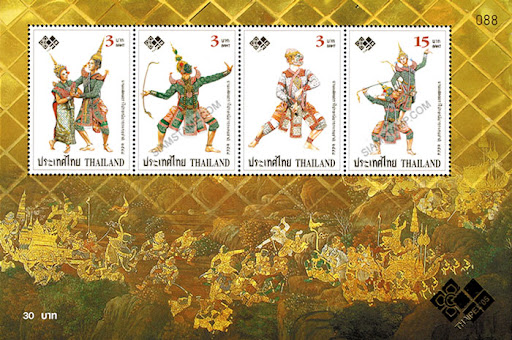 Postal Stamps of Thialand
Postal Stamps of Thialand
In 1971, two tickets were drawn on the occasion of the Ramayana International Festival. One of them shows Rama-Sita and Marich in the form of a deer. Another ticket depicts Rama, Marich in the form of a deer, and Ravana behind him. A set of three tickets were issued in 2010. One of the tickets is on Hanuman.
In 2016, Indonesia released a set of three stamps to celebrate the Chinese 'Year of the Monkey'. It has a stamp on Sugriva, Angad, and Hanuman respectively. In 2018, to mark 70 years of India-Indonesia political relationship, Indonesia released a ticket on Ramayana. It depicts Jatayu fighting Ravana to save Sita from Ravana's clutches.
Thailand tickets featuring masks
Thailand has a very close relationship with our country for the past two thousand years. This country is located in the middle of the Indochina peninsula in Southeast Asia. Thailand is the territory of the Thai people. Its original name is Syam or Shyam. The kings of this country still call themselves Ram.
The name of the king who came to the throne of this country in May 2019 is the tenth Rama. The country issued a set of eight stamps in 1973 based on various scenes from the Ramayana. It includes the scenes of Ashoka-Vatika, Ravana's umbrella, the monkey army crossing the ocean, etc.
The Ramaken, a Thai codification of the Ramayana. Among these is the traditional dance-drama 'Khon'. In this, all the characters act in different masks accordingly. Thailand issued a set of four stamps on these masks in 1975. It shows the masks of Tosakanth i.e. Dashakand Ravana, Kumbhakarna, Rama, and Hanuman.
A ticket issued in 1981 depicts a mask used in the dance-drama Khon. This mask belongs to Indrajit (Meghnad). A ticket issued in 1996 shows Rama hunting the golden deer Maricha. A set of four stamps was issued in 2005. It depicts scenes of the Rama-Sita meeting, Ravana, Hanuman, and Rama-Ravana war.
ALSO READ :Lord Ram has been traced as a historic figure through coins from 12th century
Rama and Sita are depicted in the Burmese text of the Ramayana "Yama Zatdaw" and the Philippines, the famous Singkil dance depicts the local version of the Ramayana “Darangen.”
(Both the authors are scholars of postage stamps)
